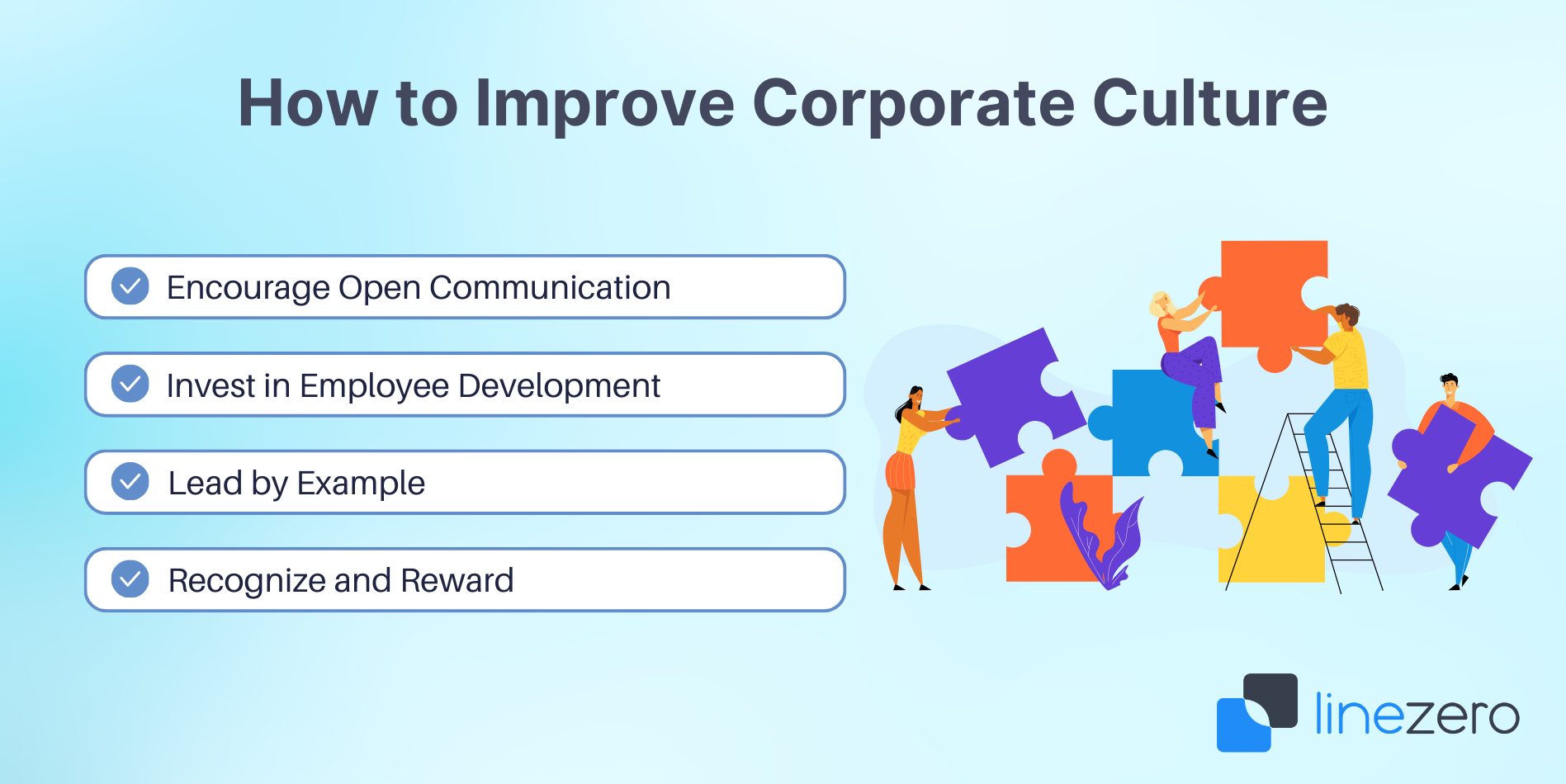Company culture is a powerful force that shapes the identity and success of organizations. It can be a tricky thing to define, so what is it exactly? Well, to begin with, it’s the shared values, beliefs, and practices that define how a company operates and how its employees interact.
In this blog post, we'll delve into the intricacies of corporate culture, exploring its definition, the significance it holds, and practical strategies on how to enhance and improve it.
Table of contents:
🚀 How to Improve Corporate Culture?
👫 Types of Organizational Culture
What is Corporate Culture?
Let’s start with figuring out exactly what corporate culture is. Corporate culture, often referred to as company culture, is the collective personality of an organization. It's the amalgamation of values, behaviours, traditions, and social interactions that shape the work environment. Company culture is not just a buzzword; it's a living, breathing aspect that shapes the very fabric of your workplace.
At its core, company culture is the heartbeat of an organization. It's the total of shared beliefs, practices, and attitudes that influence how individuals within the organization interact with each other, with clients, and with the broader community. More than just a set of policies or mission statements, company culture is the lived experience of everyone within the organization – from leadership to entry-level employees.
This intangible but influential aspect of a workplace plays a pivotal role in shaping overall work experience and organizational success.

How to Improve Corporate Culture?
Enhancing corporate culture can be a tricky thing. It requires a strategic and intentional approach. Let’s discuss some effective ways to improve company culture.
Define Core Values:
Start by identifying and clearly articulating the core values that represent the essence of your organization. These values should align with the mission and vision, serving as a guiding compass for decision-making and behavior.
Encourage Open Communication:
Foster an environment where communication is transparent and inclusive. Encourage feedback from employees and ensure that their voices are heard. This not only enhances collaboration but also builds trust and a sense of belonging.
Invest in Employee Development:
Prioritize employee growth and development. Support continuous learning, provide training opportunities, and create pathways for career advancement. When employees feel invested in, they are more likely to be engaged and committed.
Lead by Example:
Leadership plays a crucial role in setting the tone for company culture. Leaders should embody the desired values and behaviors, providing a model for employees to follow. When leadership demonstrates a commitment to the established culture, it cascades throughout the organization. A good example of this is Apple Inc. and how it’s been influenced by Steve Jobs’ vision for the company. Encouraging creativity, innovation, and open communication.
Recognize and Reward:
Acknowledge and celebrate achievements, both big and small. Recognition reinforces positive behavior and motivates employees to contribute their best. Implementing a robust reward system fosters a culture of appreciation and acknowledgment.
Types of Organizational Culture:
Organizational cultures can be categorized into several types based on the prevalent values and behaviors within the organization. Some common types include:
Clan Culture:
- Characterized by a family-like atmosphere, this culture emphasizes collaboration, teamwork, and a sense of belonging. Open communication and a focus on employee development are hallmarks of clan cultures.
Adhocracy Culture:
- Organizations with an adhocracy culture prioritize innovation, risk-taking, and adaptability. This culture encourages experimentation and is often found in dynamic and creative industries.
Hierarchy Culture:
- A hierarchy culture is characterized by a structured and controlled environment. Organizations with this culture value stability, efficiency, and a clear chain of command.
Market Culture:
- Organizations with a market culture are results-oriented and competitive. They focus on achieving measurable goals, beating competitors, and maintaining a strong market position.
Company Culture Types:
Every company thrives on an invisible, yet powerful force: its culture. It's the unique blend of values, beliefs, and behaviors that define how employees interact, collaborate, and ultimately achieve success. But just like snowflakes, no two company cultures are identical. Let's delve into three distinct types to understand how they shape your organization's DNA:
Inclusive Culture:
Imagine a workplace where diverse backgrounds, experiences, and perspectives are celebrated. That's the essence of an inclusive culture, championed by companies like Salesforce. Here, inclusion goes beyond just words; it's woven into the fabric of the organization, from hiring practices to everyday interactions. Employees feel valued, respected, and empowered to bring their authentic selves to work, fostering a strong sense of belonging and collaboration. This, in turn, leads to increased creativity, innovation, and ultimately, a more engaged and productive workforce.
Results-Driven Culture:
For organizations like sales-oriented companies, hitting targets and exceeding expectations are the name of the game. This is where a results-driven culture takes center stage. Here, clear goals, defined metrics, and performance measurement are crucial. Employees are motivated by achieving KPIs and exceeding expectations, often fueled by incentives and recognition programs. This approach can be highly effective in driving productivity and achieving specific objectives. However, it's important to maintain a healthy balance to avoid burnout and foster a collaborative environment where open communication and teamwork are still valued.
Innovative Culture:
Think SpaceX and Tesla, companies synonymous with pushing boundaries and redefining industries. This is the essence of an innovative culture. Here, creativity, risk-taking, and a willingness to challenge the status quo are encouraged. Employees are empowered to experiment, share ideas freely, and learn from failures. This fosters a dynamic environment where new solutions and groundbreaking ideas are constantly emerging. However, it's crucial to ensure a supportive structure with clear communication and risk management strategies to navigate the inevitable uncertainties inherent in pushing the boundaries..png?width=1897&height=950&name=Culture%20types%20(1).png)
Examples of Organizational Culture:
While understanding various company culture typologies like "Inclusive" or "Results-Driven" offers a framework, the true essence lies in witnessing these values play out in real-world examples. Let's dive into the vibrant tapestries woven by several renowned organizations:
Netflix: Where Freedom Breeds Innovation
"Freedom and Responsibility" isn't just a motto at Netflix; it's a way of life. This translates to unlimited paid vacation, generous parental leave policies, and no expense reports. The trust they place in their employees manifests in their flat organizational structure, where titles hold little weight and ideas flow freely. This translates to impressive results: a 2023 study by Glassdoor placed them on their Best Places to Work list, with employees praising the culture of ownership and personal growth.
Southwest Airlines:
Southwest Airlines takes "people-centric" to new heights. Their unique culture, often described as "fun, friendly, and a bit quirky," emphasizes employee happiness and empowerment. This isn't just lip service; Southwest boasts the lowest employee turnover rate among major airlines, a testament to their commitment to their crew. This focus translates to award-winning customer service, with passengers consistently praising the warm, welcoming atmosphere onboard.IBM:
Think "Big Blue," but imagine an environment buzzing with collaborative energy. That's IBM's culture in a nutshell. The company fosters a strong culture of research and development, encouraging employees from diverse backgrounds to come together on game-changing projects. This collaborative spirit has birthed groundbreaking innovations like the Watson AI platform and quantum computing advancements. While not without its challenges, IBM's commitment to collaboration has helped it maintain its position as a leading technology innovator.
LineZero:
Imagine a workplace where purpose and progress dance in harmony. At LineZero, a B Corp, social good isn't just a tagline; it's the rhythm of our culture.
We connect employees, fostering a shared purpose with innovative tools like Workplace from Meta. Success is a shared song celebrated by every team member.
But LineZero's music goes deeper. They create an inclusive environment where everyone feels valued and empowered to contribute. It's not just a job, it's a community where individuals thrive personally and professionally, making a positive impact on the world.
.png?width=1440&height=558&name=Unlock%20Your%20Digital%20Future%20(1).png)
Conclusion:
Company culture is a dynamic and influential aspect that significantly impacts an organization's success and the well-being of its employees. But, of course, it’s more than just corporate success. It’s about the connection employees have with each other and with the company. It's their values, the decisions they make, the way they navigate their work, and ultimately, their lives.
Defining, understanding, and actively improving corporate culture is an ongoing process that requires commitment from leadership and engagement from every individual within the organization. By fostering a positive and aligned company culture, organizations can create environments where employees thrive, innovation flourishes, and success becomes a shared journey.
At LineZero, we acknowledge the importance of a positive team culture. Recognizing that the future of work is hybrid, an internal communication tool like Workplace from Meta can be game-changing in building and fostering a positive culture.
Learn more about how you can implement Workplace in your company and be part of the future of work.
Let’s Start Your Workplace Journey!
Tags:
Corporate CultureFebruary 23, 2024



Comments